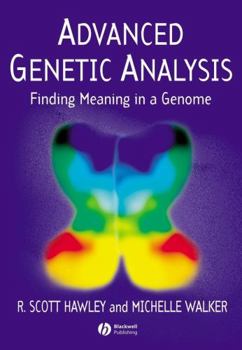Advanced Genetic Analysis: Finding Meaning in a Genome
Select Format
Select Condition 
Book Overview
Advanced Genetic Analysis brings a state-of-the-art, exciting new approach to genetic analysis. Focusing on the underlying principles of modern genetic analysis, this book provides the 'how' and 'why' of the essential analytical tools needed. The author's vibrant, accessible style provides an easy guide to difficult genetic concepts, from mutation and gene function to gene mapping and chromosome segregation. Throughout, a balanced range of model organisms and timely examples are used to illustrate the theoretical basics.
Basic principles - Focuses students attention on the 'how' and 'why' of the essential analytical tools. Vibrant, accessible style provides an easy guide through difficult genetic concepts and techniques. Text boxes highlight key questions and timely examples. Boxes of key information in each chapter, chapter summaries and extensive references - prompt the student to synthesise and reinforce the chapter material. Special reference section addressing a range of model organisms to help provide a particularly relevant context for students' research interests.Format:Paperback
Language:English
ISBN:1405103361
ISBN13:9781405103367
Release Date:January 2003
Publisher:Wiley-Blackwell
Length:256 Pages
Weight:1.12 lbs.
Dimensions:0.5" x 7.4" x 9.7"
Customer Reviews
3 ratings
Outstanding text
Published by Thriftbooks.com User , 16 years ago
This is an outstanding textbook for a course in (surprise) Advanced Genetic Analysis. As previous reviewers have indicated, it is a book any practicing geneticist should love. It describes the logic, and well as the methodology of genetic analysis, and provides brief descriptions of various model organisms (including Arabidopsis!). Furthermore, the writing is beautiful--Hawley and Walker should be complemented for producing a genetics textbook that is both entertaining to read as well as informative. My only complaint is that it is too brief and a little uneven. Some topics are missing or are dealt with in only a few sentences (e.g. positional cloning/molecular markers, genetic analysis of natural variation, mapping tools such as RILs) and others (meiotic recombination--the author's specialty) receive a bit too much emphasis. Hopefully, these minor flaws will be corrected in a new edition. I wish I had stumbled across this text when it first came out. It would have saved me a lot of photocopying.
Excellent text for grad level genetics
Published by Thriftbooks.com User , 16 years ago
This is an excellent, concise text for classical genetics. While most introductory texts like "Introduction to Genetic Analysis" is 90% molecular biology and 10% genetics, this book assumes that the reader has enough background to skip the usual obligatory exposition on DNA and translation, etc., and jumps straight to topics such as designing mutagenesis screens and epistatic analysis. This book is particularly strong in presenting genetics formalism to new students, and concepts usually glossed over in other texts (eg. dominant/recessive alleles, complementation) are explained in great detail, and possible pitfalls in experiment or interpretation are frequently discussed. Researchers and students working on specific model organisms may find this book a little too general, but it is the perfect text for new grad students interested in genetics.
Excellent textbook for the research scientist
Published by Thriftbooks.com User , 18 years ago
This is the first book I've encountered that discusses genetics from the point of view of the research scientist. I use it in my first year graduate genetics class. For instance, chapter 2 is entirely devoted to mutant hunts. Another chapter covers extragenic suppressors- even allele specific suppression. Chapter 5 covers epistasis and mosaic analysis. Alas, there is even a comprehensible discussion of LOD scores. This is all great stuff that any geneticist will love. However, any book falls short on something. The emphasis is on non-mammalian model organisms. Thus, there is very little discussion of the use and pitfalls of dominant negatives and RNAi and no discussion of gene targeting in mice. The book would also benefit by a discussion of modern genomic methods.






